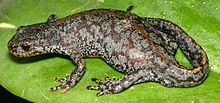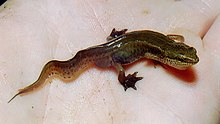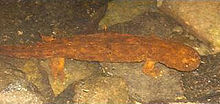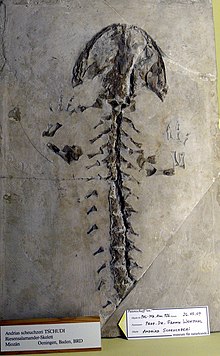Tail amphibian
| Tail amphibian | ||||||||||||
|---|---|---|---|---|---|---|---|---|---|---|---|---|

Fire salamander ( Salamandra salamandra ); the best-known European salamander |
||||||||||||
| Systematics | ||||||||||||
|
||||||||||||
| Scientific name | ||||||||||||
| Caudata | ||||||||||||
| Fischer von Waldheim , 1813 | ||||||||||||
| Superfamilies | ||||||||||||
|
The caudate amphibian (caudata; also: urodela which sometimes only refers to the crown group ) are one of three orders of amphibians . In purely colloquial terms, they are often divided into salamanders and newts , depending on whether they are more adapted to rural life ("salamanders") or show a greater connection to the water as a habitat, for example through the flippers on the tail ("newts"). However, the so-called salamanders are also often dependent on bodies of water for oviposition or larval development. Conversely, many newts spend part of their lives on land. From a systematic point of view , these two colloquial terms are therefore rather unsuitable.
features
The body length ranges from barely more than three centimeters (some species of the Mexican genus Thorius , lungless salamanders) to the giant salamanders, which are sometimes more than one and a half meters long, which are also the largest amphibians of our time.
All tailed amphibians have an elongated body and a tail, which - depending on the species systematic affiliation or the seasonal phase of life - can be rounded or laterally flattened in cross-section and provided with skin borders. With the exception of the arm newts, which have no hind legs, all tailed amphibians have four limbs of roughly the same length, on which the animals - provided they are on land - move around (not hopping or jumping like frogs ).
Certain features in the rest of the bone structure (for example, structure and, with 30 to 100 pieces, a much larger number of vertebrae) as well as in the formation of teeth in the jaws are all common or separate them from the frogs. In contrast to most frogs, tailed amphibians still have free ribs (exception: giant salamanders); Their shoulder and pelvic girdles are predominantly cartilaginous and less firmly connected to the spine than in the anura .
Newts and salamanders generally lack the eardrum and middle ear . The sense of smell is likely to play a greater role than in frogs and toads.
Adult tail amphibians usually breathe with their lungs and through their skin; In the lungless salamanders, however, gas exchange only takes place via the skin and the mucous membranes of the oral cavity.
Reproduction and Individual Development
Unlike the frogs, in which the spawns are inseminated externally , tail amphibians practice indirect internal fertilization (apart from the Cryptobranchoidea, which have other characteristics). To do this, the female usually ingests a sperm packet ( spermatophore ) previously deposited by the male with his cloaca . Many tail amphibians lay eggs in water and spend a larval phase in the water; only a few are viviparous ( ovoviviparous ). Most representatives of the most species-rich family of the lungless salamanders (Plethodontidae) deposit their eggs on land.
The larvae living in the water ( only the larvae of the frogfish are called " tadpoles ") usually have outer gill tufts and initially develop the front extremities . Unlike tadpoles, their diet is exclusively carnivorous .
A special phenomenon is the neoteny , in which larvae do not reach a complete metamorphosis to the land animal, but retain larval characteristics throughout their life. This phenomenon, also known as pedomorphism (“child figure”), is not uncommon. The best known examples are the axolotl and the grotto olm .
Another characteristic of many amphibians, including adults, is their ability to regenerate lost limbs or the tail. In the case of the frogs this only works in the development stage of the tadpole.
distribution
Tail amphibians are mainly holarctic , i.e. widespread in moderately temperate to subtropical regions of the northern hemisphere . Nine out of ten families can be found in the USA alone . Only some of the lungless salamanders (Plethodontidae) in Latin America also reach the tropics and cross the equator .
Specifically, North, Central and Northwest South America, Europe, the extreme Northwest of Africa and parts of Asia are settled. There are no tailed amphibians in Australia.
Systematics
"Urodela" is considered by some authors to be the scientific name for the amphibian amphibian which is valid according to the nomenclature provisions; in the American-speaking world, however, the name "Caudata" is mostly used.
The order is divided into three superfamilies. The most primitive are the Cryptobranchoidea ( giant salamander and Asiatic salamander ), which occur in East Asia and North America and can be partly 1.5 (1.8) meters long, and also aquatil living sirenidae (Sirenoidea) from the southeastern United States. In by far the largest superfamily, the salamander relatives (Salamandroidea), all salamanders and newts occurring in Europe are represented.
About 580 species are currently known, although this number may constantly change slightly due to phylogenesis research.
The following table shows a system of the recent tail amphibians with all genera and also a selection of species (Europe with around 40 species as complete as possible). The superfamilies and families are sorted alphabetically according to the scientific name. The taxa from the family Salamandridae that occur naturally in Germany, Austria and Switzerland are highlighted in bold.








- Superfamily Cryptobranchoidea
- Giant salamander family (Cryptobranchidae)
- Genus Asian giant salamander ( Andrias )
- Species Chinese giant salamander ( A. davidianus )
- Species Japanese giant salamander ( A. japonicus )
- Genus American giant salamander ( Cryptobranchus )
- Type mud devil or Light Bender ( C. alleganiensis )
- Genus Asian giant salamander ( Andrias )
- Family Asiatic salamander (Hynobiidae)
- Genus Asiatic mountain newts ( Batrachuperus )
- Genus Hynobius
- Genus Clawed Newts ( Onychodactylus )
- Genus Pachyhynobius
- Genus Protohynobius
- Genus frog-tooth newts ( Ranodon )
- Genus Salamandrella
- Giant salamander family (Cryptobranchidae)
- Superfamily sirenidae ( Sirenoidea )
- Family sirenidae (Sirenidae)
- Genus Little Newts ( Pseudobranchus )
- Genus arm newts ( Siren )
- Family sirenidae (Sirenidae)
- Superfamily salamander relatives ( Salamandroidea )
- Family transverse newts (Ambystomatidae)
- Genus true transverse newts ( Ambystoma )
- Species Lerma cross-toothed newt ( A. lermaense )
- Axolotl species ( A. mexicanum )
- Species tiger salamander ( A. tigrinum )
- Genus true transverse newts ( Ambystoma )
- Family eel newts (Amphiumidae)
- Genus Amphiuma
- Species three-toed eel newt ( A. tridactylum )
- Genus Amphiuma
- Family of giant transverse newts (Dicamptodontidae)
- Genus Dicamptodon
- Genus Rhyacosiredon
- Family lungless salamanders (Plethodontidae)
- Subfamily Bolitoglossinae
- Genus worm salamander ( Batrachoseps )
- Genus mushroom-tongue salamander ( Bolitoglossa )
- Genus Callus Salamander ( Chiropterotriton )
- Genus Dendrotriton
- Genus Ixalotriton
- Genus Lineatriton
- Genus Nototriton
- Genus Nyctanolis
- Genus Tropical Salamander ( Oedipina )
- Species Oedipina paucidentata
- Genus Parvimenue
- Genus Mexican salamander ( Pseudoeurycea )
- Species Pseudoeurycea naucampatepetl
- Species Pseudoeurycea saltator
- Subfamily Hemidactyliinae
- Genus Hemidactylium
- Species four-toed salamander ( H. scutatum )
- Genus Hemidactylium
- Subfamily Plethodontinae
- Genus tree salamander ( Aneides )
- Species alligator salamander ( A. lugubris )
- Genus brook salamander ( Desmognathus )
- Genus Eschscholtz Salamander ( Ensatina )
- Genus Hydromantes
- Genus creeping salamander ( Phaeognathus )
- Genus forest salamander ( Plethodon )
- Species silver salamander ( P. glutinosus )
- Species red-cheeked forest salamander ( P. jordani )
- Genus European cave salamanders ( Speleomantes ) (in some overviews only synonym of hydromantes )
- Species Ambrosis cave salamander ( S. ambrosii )
- Species Monte Albo Cave Salamander ( S. flavus )
- Art Genés Cave Salamander ( S. genei )
- Species Scented Cave Salamander ( S. imperialis )
- Species Italian cave salamander ( S. italicus )
- Species Sàrrabus cave salamander ( S. sarrabusensis )
- Species Ligurian cave salamander ( S. strinatii )
- Species Sopramonte cave salamander ( S. supramontis )
- Genus tree salamander ( Aneides )
- Subfamily Spelerpinae
- Genus yellow salamander ( Eurycea )
- Species Texan well newt ( E. rathbuni )
- Genus spring salamander ( Gyrinophilus )
- Genus Haideotriton
- Genus mud salamander ( Pseudotriton )
- Species red salamander ( P. ruber )
- Genus Striped Salamander ( Stereochilus )
- Genus Urspelerpes
- Species Urspelerpes brucei
- Genus yellow salamander ( Eurycea )
- Subfamily Bolitoglossinae
- Olme family (Proteidae)
- Genus Furchenmolche ( Necturus )
- Species Alabama newt ( N. alabamensis )
- Species spotted newt ( N. maculosus )
- Genus Proteus
- Species cave olm ( P. anguinus )
- Genus Furchenmolche ( Necturus )
- Family Rhyacotritonidae
- Genus Rhyacotriton
- Family real salamanders and newts (Salamandridae)
- Genus Pyrenean Newts ( Calotriton )
- Species Montseny mountain newt ( C. arnoldi )
- Species Pyrenean Newt ( C. asper )
- Genus Chioglossa
- Type gold-striped salamander ( Ch. Lusitanica )
- Genus fire-bellied newts ( Cynops )
- Species swordtail newt ( C. ensicauda )
- Species Japanese fire-bellied newt ( C. pyrrhogaster )
- Species Chinese fire-bellied newt ( C. orientalis )
- Genus Echinotriton
- Genus Tyrrhenian Newts ( Euproctus )
- Species Corsican mountain newt ( E. montanus )
- Species Sardinian mountain newt ( E. platycephalus )
- Genus Ichthyosaura
- Species mountain newt ( I. alpestris )
- Genus Lissotriton (Small European Newts)
- Species Spanish newt ( L. boscai )
- Type of newt ( L. helveticus )
- Species Italian newt ( L. italicus )
- Species Carpathian newt ( L. montandoni )
- Type Teichmolch ( L. vulgaris )
- Genus Lycian Salamander ( Lyciasalamandra )
- Species Lyciasalamandra helverseni
- Species Lyciasalamandra luschani
- Genus Mertensiella
- Species Caucasian salamander ( M. caucasica )
- Genus Neurergus
- Genus East American Newts ( Notophthalmus )
- Species Greenish Newt ( N. viridescens )
- Genus banded newts ( Ommatotriton )
- Species Northern banded newt ( O. ophryticus )
- Species southern banded newt ( O. vittatus )
- Genus short-footed newts ( Pachytriton )
- Species Chinese short-footed newt ( P. brevipes )
- Genus warts newts ( Paramesotriton )
- Genus Ribbed Newts ( Pleurodeles )
- Species Spanish ribbed newt ( P. waltl )
- Genus Actual Salamander ( Salamandra )
- Species alpine salamander ( S. atra )
- Species Corsican fire salamander ( S. corsica )
- Species Lanza's Alpine Salamander ( S. lanzai )
- Species South Spanish fire salamander ( S. longirostris )
- Species fire salamander ( S. salamandra )
- Genus glasses Salamander ( Salamandrina )
- Species Northern Spectacled Salamander ( S. perspicillata )
- Species Southern Spectacled Salamander ( S. terdigitata )
- Genus Western Newts ( Taricha )
- Species rough-skinned yellow-bellied newt ( T. granulosa )
- Genus Triturus (crested and marble newts)
- Species Alpine crested newt ( T. carnifex )
- Species Northern crested newt ( T. cristatus )
- Species Danube crested newt ( T. dobrogicus )
- Art Buresch's crested newt ( T. ivanbureschi )
- Species Asiatic crested newt ( T. karelinii )
- Species Macedonian crested newt ( T. macedonicus )
- Type marble newt ( T. marmoratus )
- Species dwarf marble newt ( T. pygmaeus )
- Genus crocodile newts ( Tylototriton )
- Species buttoned Birman crocodile newt (
- Genus Pyrenean Newts ( Calotriton )
- Family transverse newts (Ambystomatidae)
|
See also: Systematics of amphibians |
Tribal history
As with frog amphibians and crawling amphibians , the oldest fossils come from the tribal group of the tail amphibians from the Triassic . Triassurus sixtelae is around 230 million years old, was found in the Madygen Formation in southwestern Kyrgyzstan and scientifically described in mid-2020. The species shares some original characteristics with the extinct Temnospondyli , particularly with the Branchiosauridae and the Amphibamidae . Marble peton from the middle Jurassic of England, also a core group representative, was likely entirely aquatic. Chunerpeton comes from the Central Jurassic of Inner Mongolia and is related to the recent giant salamanders (Cryptobranchidae). The oldest known salamander relative (Salamandroidea) is Beiynerpeton , whose fossil remains , around 157 million years old ( Upper Jurassic ) were found in the Tiaojishan Formation in the Chinese province of Liaoning .
Karaurus comes from the Upper Jurassic of Kazakhstan . Almost complete skeletons of this genus have been passed down, which suggest that the approximately 12 cm long animals were terrestrial. The tiny, fragile skeletons of the tail amphibians were rarely preserved in the rocks of the Mesozoic Era. However, since prehistoric salamander fossils are increasing in Central Asia, it stands to reason that the roots of the salamander are in this region. The extinct Batrachosauroididae , which only occur in North America , appeared in the late Jurassic, resembled the Olmen (Proteidae) and, like them, were probably aquatic. They can be detected up to the early Pliocene . In the Upper Cretaceous occurred to Armmolchen (Sirenidae) similar family with two genera, Prosiren from Texas and Ramonellus from Israel. Like the arm newts, the animals were elongated and lacked their hind legs. It is still unclear whether they are really more closely related to the arm newts. Valdotriton from the late Barremium of Spain is known for six complete skeletons and belongs to the salamander relatives, without being able to be assigned to a recent family. Anatomically, the genus mediates between the Olmen and the other salamander relatives. In the Upper Cretaceous two families that still exist today appeared, the eel newts (Amphiumidae) and the arm newts , as well as the Scapherpetontidae , which disappeared again in the early Eocene . Proamphiuma from Cretaceous deposits in Montana is the earliest known eel newt and predecessor of the recent genus Amphiuma . Fossil arm newts are Kababisha from Africa, Notoerpeton from South America and the large Habrosaurus genus from North America, which survived until the early Paleocene . Younger arm newts are also known from Africa. The recent genus Siren has been found in North America since the middle Eocene and the pygmy newts ( Pseudobranchus ) appeared in Florida in the Pliocene. The Scapherpetontidae occurred in North America from the late Cretaceous to the early Eocene. Scapherpeton and Piceoerpeton were similar to the recent salamander genus Dicamptodon , Lisserpeton had an elongated body and reduced legs. The giant transverse newts (Dicamptodontidae) appeared in North America after the extinction of the Scapherpetontidae and, like their current representatives, seem to be associated with the redwood flora.
The giant salamanders (Cryptobranchidae), the olms and the real salamanders (Salamandridae) appeared in the Paleocene. The recent genus Cryptobranchus left behind fossils from the Paleocene in Saskatchewan and was also found in the Pleistocene of the Appalachians. Fossils of Andrias , the second genus of the giant salamander, have been found in Europe, North America and Japan, with Andrias Scheuchzeri from the Upper Oligocene being the oldest species of the genus. No fossil finds of the angular- tooth newts (Hynobiidae) have been found so far. The Olms appeared in the late Paleocene in North America and in the Middle Miocene in Europe. Some fossils can be assigned to the recent genera Necturus and Proteus , others two newly introduced extinct genera. The genus Ambystoma has occurred in North America since the Eocene and is common in Pleistocene fossil sites. The family of the real salamanders and newts (Salamandridae) is particularly well represented in the fossil record. 18 genera and more than 50 species are known. The recent genus Salamandra and the crocodile newts ( Tylototriton ) are already known from the Eocene, Taricha and Triturus from the Oligocene and Notophthalmus from the Miocene. The fossil record of the most species-rich salamander family , the lungless salamander (Plethodontidae), on the other hand, is extremely sparse and of the six named fossil genera, four are only known from the Pleistocene. Some vertebrae of the animals were found in Montana which are dated to the early Miocene and footprints of a lungless salamander found in California date from the early Pliocene.
Web links
- Amphibiaweb.org ( Memento of August 21, 2009 in the Internet Archive ) (English)
- Database "Amphibian Species of the World" (English)
- IUCN: Amphibians (English)
Individual evidence
- ↑ Ken Muneoka, Manjong Han & David M. Gardiner: Regeneration: Could Human Limbs Regrow? Spectrum of Science ( online edition, September 26, 2008)
- ^ A. Sánchez Alvarado: A cellular view of regeneration. Nature 460: 39-40. (July 2, 2009) PMID 19571870
- ^ Rainer R. Schoch, Ralf Werneburg and Sebastian Voigt: A Triassic stem-salamander from Kyrgyzstan and the origin of salamanders. PNAS, 2020 doi: 10.1073 / pnas.2001424117
- ↑ a b c Laurie J. Vitt and Janalee P. Caldwell: Herpetology: An Introductory Biology of Amphibians and Reptiles. Academic Press, 2013, ISBN 978-0123869197 , pages 89-92.
- ↑ Nadja Podbregar: The world's oldest salamander discovers a 330 million year old fossil sheds new light on the early development of amphibians May 12, 2020, scinexx.de














